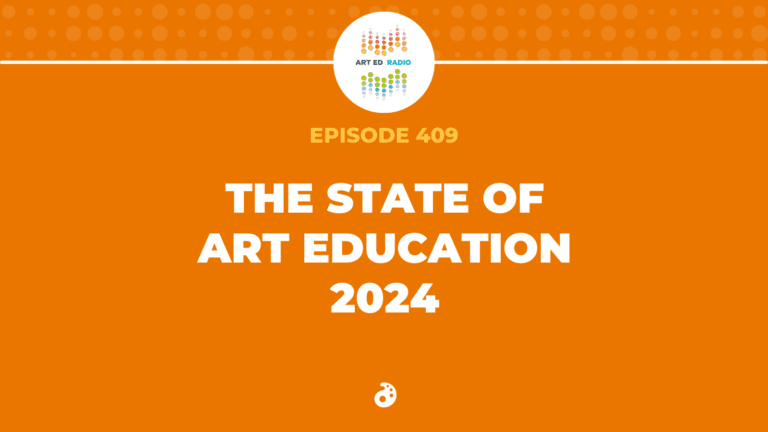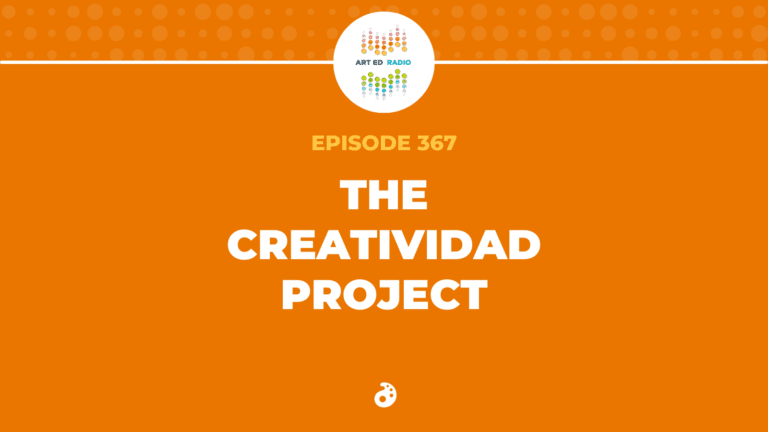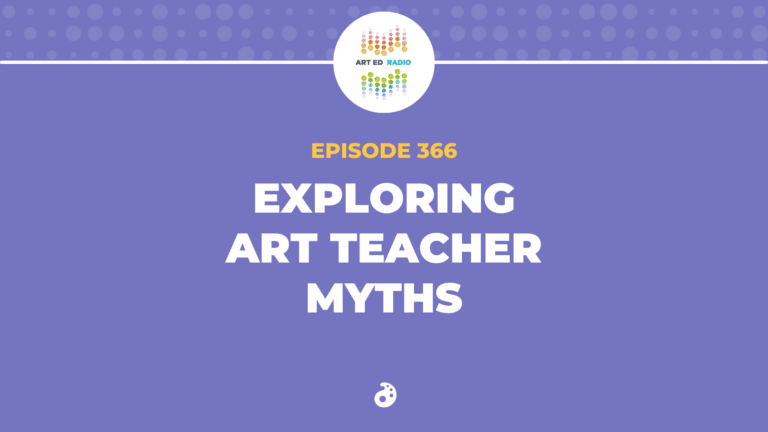Today, Jordan DeWilde returns to the show to share with Nic how his year has been going and what ideas have been working for him and his students. In this wide-ranging conversation, they discuss the importance of engaging students through contemporary art, the joy of animation, and how we can continue to help each other via social media. Full Episode Transcript Below.
Resources and Links
- Follow Jordan on Instagram
- Artist Animators Your Students Will Love
- Art Teachers Who Are Making the Most of This Year
- Comparing Classic and Contemporary Artists
- The Stop-Motion Animation FLEX Collection

Transcript
Nic: Today we’re going to talk to Jordan DeWilde who is… Well, he’s a middle school art teacher currently. He has quite a background, I’ll let him explain that a little bit more. But he is very much involved with the Art of Education University. He’s done PRO Packs and he’s been on our conferences on a regular basis, Art Ed NOW, but we are going to talk about the articles that he so often writes. He creates some great content for the Art of Education University’s magazine. And so we’re going to chat about a couple of recent articles that he has written.
This is Everyday Art Room and I’m your host, Nic Hahn.
Hey, Jordan, I want to thank you for being on the podcast again. I’m really excited to have you on the podcast again. Can you go ahead and introduce yourself? I know you have a different role than you did in the past so let’s just get started with the introduction.
Jordan: Yeah. So my name is Jordan DeWilde and I am teaching junior high for the first time in my career. This is my ninth year of teaching art. I’ve previously taught a year of high school and then before that, I did eight years of elementary from third to sixth grade. So I’ve had sixth-graders before but never in a junior high setting. So it’s a new experience for me but I’m rolling with it and this 2020 remote learning atmosphere.
Nic: Yeah. Yes, and it’s so nice to have that under your belt, that whole kindergarten through 12th-grade experience. What a great thing, that’s awesome. Are you enjoying the middle school?
Jordan: Yeah. It’s hard to… I can’t say that it’s a real middle school experience yet because I’m actually working remotely. So I’m getting to know students through Zoom but there’s definitely that, from what I’ve gathered from my colleagues, I can’t really say that I’ve earned my junior high stripes yet until I get to see them in the building, I think.
Nic: Yeah, okay, I understand that and I would concur. Especially if you haven’t had them in the spring yet, they get real stinky then.
Jordan: Yeah, I can imagine. I do think having that elementary and then high school bookends first will serve me well but we’ll see how it goes in the spring.
Nic: No, and I’ll say, I have middle schoolers living in my home right now and that’s why I can say that with such love. And I do like middle school a ton, it was a fun part of my career as well. Yeah, absolutely. So we talked about your current teaching situation. You’re doing in hybrid right now totally, is that it?
Jordan: Yeah, we’re totally 100% remote-
Nic: Online.
Jordan: Yeah. We’re online for right now 100%. We are going to soon switch gradually into a hybrid situation. So in the next few weeks, my sixth graders are going to come back to school, or have that opportunity. So we don’t know exactly how many just yet but those families that elect to come back in person, I would be teaching in the building and then I would still have my seventh and eighth remote. And it’ll be a hybrid situation where it’s an AB schedule, so half the students would come two days, the other half would come another two days. So all those details are still a little bit vague until we get our numbers but I do like that we’re gradually moving into that direction instead of ripping the bandaid off and having a host of all kinds of problems. So I hope there’s a smart, safe way to transition back.
Nic: Yeah, that sounds interesting. Every single place is coming up with their own way to do this. Do you think that this is typical for your area or Illinois? Have you noticed that?
Jordan: There are a lot of areas around us. So I’m in Bloomington and there are a lot of smaller schools around us that have been fully in person. And luckily, fortunately for them, they haven’t had much problems with having any cases of COVID in the student population. So I think that serves as a good sign and we can look to the measures that they’ve taken. We are a much bigger school and so I think there’s some concern there, but I think with the time that we’ve been fully remote this whole school year, I think the district and the administration has had plenty of time to see what other schools have done and make a plan that works for our unique group of students and how many students we have in our building.
So I would say I think a lot of my friends are in schools where they are teaching in-person, at least part of the time, whether it’s hybrid or fully. So I don’t have a lot of connections with colleagues who are fully remote like I am. So it’s been a unique experience but I’m actually really glad that I started this way and then can move into whatever crazy hurdles there will be with hybrid. I think I’ll be prepared at least on the technology side from having been remote.
Nic: Yeah, that you already have it and your students are already using it. Interesting.
Jordan: Right.
Nic: So recently, and I just love talking to you anyways, but you wrote a recent article last month about five animators that you love to present to your students. Before talking more about that, can you share a little bit about how you get kids engaged with animation and what draws them to it?
Jordan: Sure. When I started working in Bloomington, I have a co-art teacher… well, another art teacher in the building, and she had an animation unit existing for seventh grade and she wanted to continue it even though we were going to be working remotely. And I was super intimidated by that because I’m coming from a district where we had so many problems with student access to technology and there’s a host of problems that could come with that. And I’m just thinking animation, man, that’s going to be really difficult to get students across the board to be able to turn something in and be successful with it.
Also, I was a little intimidated but I really think… and my coworker is Jen Baker and she does a lot of great work in Illinois for art education. And she just really had some great ideas for making animation work remotely. So we’re doing flipbooks and we’re doing stop motion animation on phone apps or tablet apps, which fortunately we haven’t really had any student who was unable to do that. So I was scared of that coming into it but I’m glad… and I’ve seen a lot of great success from students.
So just knowing that I’m going to be coming into this animation unit before the school year even starts and having these concerns about it, I’ve never even taught animation in my career. Really wanted to have a host of animators that I can share with students beyond what Jen had already established in her unit because I always feel like you can sell a lesson a lot more when you make it your own and you have your own connection to it.
Nic: Yeah.
Jordan: So Jen had shared a lot of great animators like Tim Burton with them and even a history of animation over time. So she had that already set and I just wanted to incorporate ones that either I already loved and wanted to share with students, or I wanted to research and find a few more that I thought that they would be engaged with. So one that struck me right away was William Kentridge who I’m not sure would define himself as an animator. He’s an artist of multiple disciplines but in his charcoal drawing animations are basically like a stop motion. He does these large-scale charcoal drawings and then takes pictures of them in progress and then you see the history of the mark. With charcoal, you can erase very easily but there’s still that faint-
Nic: Yeah.
Jordan: Yeah, and they’re just really cool. And I saw them when I was in college in a contemporary art course and just thought they were really amazing. He does a lot of work on the subject matter of apartheid in South Africa and using these really dark charcoal marks in his animations and then some pops of blue or red to emphasize emotion. And so they’re just really a great way to show how fine art and animation collide.
So that was one I already had in my pocket that I knew enough of that I could speak to and can share with students. But I also wanted to show them some other ones that maybe they were more familiar with or that they could approach a little bit easier. So I thought what kind of animations do I like or do I remember as a junior high-aged kid? And I thought of the Wallace and Gromit movies by Nick Park and Chicken Run, and some of those other great animations he did with clay. And so that was a great way to introduce stop motion and was able to show students some behind the scenes videos of how those movies are made. And they recognize those characters somewhat and then have their own experience with stop motion and they can be like, “Oh, I really like this movie or this movie is really cool, or this cartoon I watch I think is stop motion.” And then they have an argument on whether it counts as stop motion or if it’s digital. And so just having those conversations with them over Zoom was pretty cool.
And then I also showed them a Mexican animator, Carlos Rupit that’s done a lot of cool things with Snapchat for corporations like Pepsi, and just doing different filters with animations and having themes that they can use. And so that obviously, connects with junior high-aged kids pretty well too. So just trying to connect with them, finding them on my own, doing some research to find animators I think kids will like. And then also sharing ones that I love as well.
Nic: Yeah. Well, that’s interesting, you brought up a couple of key points there. You mentioned, “What did I like in junior high?” And I think that’s always really important to think about what was engaging to you because a lot of things are very developmental. But then you lead yourself into saying, “But I also want to connect with them where they’re at right now.” So looking at Snapchat and different places like that for inspiration, you’re right on it, definitely, as always.
Jordan: Yeah, and I think looking for the animator’s voice too with those behind the scene videos, and I think animators, particularly because they’re working on technology and with a digital atmosphere, they’re willing to share some of that. And they’re even reflecting on their own experience from when they were younger. And then when they can see like, “Oh, this guy that made the Chicken Run movie, he’s talking about how he got started.” Or when we were doing flipbooks that’s how we started our animation unit, I showed them some animators that did flipbooks on YouTube and they talked about, “Oh, when I was a kid in school, I would draw on the pages of my notebook in the corners.” And it’s just a stick man and like, “Oh, I can do…” When they think like, “I can’t do this because it’s so random, it’s something I’ve never tried before,” but they hear a successful animator saying, “Oh, I did a stick figure running across the page.” And it wasn’t a lot of drawing talent necessarily to that but there’s that magic of making an animation, making a movement with basic drawing techniques.
Nic: Yeah, wonderful. Yeah, and you’re right, anytime that you can get the voice of the artist it’s just so powerful, so much more powerful than your teacher telling you all of that.
Jordan: Right, yeah, absolutely. And gives your voice a break because you’re talking nonstop on Zoom or in your mask or whatever, and you can give the voice to the animator, the artist’s source.
Nic: Yeah, for sure. Yup, I love it. Now, along with your lessons that you so often share in the articles that you write for the Art of Education University, you also write… I don’t know if we want to call them feel-good articles, at least this one that I want to talk about is a total feel-good. You wrote about teachers that are making the most of this year. Who did you want to highlight and why? How did you make those decisions?
Jordan: I use social media not only to post my own content out there but really to seek information and inspiration from other teachers. And there’s such a great network of art teachers out there that are sharing great ideas. And I think especially in 2020 with remote learning or hybrid or in-person with restrictions, there’s nothing in a textbook, there’s nothing that we’ve been prepared for that tells us how to approach this. And so if we can look to each other, and art teachers are often isolated in their districts, they don’t necessarily have a lot of examples of how to do their job and how to do it in such a different way. So I think social media can be a great place to get your finger on the pulse of what other art teachers are doing.
So I really looked to teachers that I’ve been following for a while, teachers that I have actually used some inspiration from, whether it’s how they use social media, or it’s a lesson that they use in their classroom, or a way that they presented their content to their students, there’s a lot of great teachers out there that are doing amazing things. But I also wanted to highlight teachers who maybe didn’t have the super following of an influencer teacher. I wanted quality content, teachers who are posting quality content, quality ideas, but maybe that the readers of the magazine hadn’t heard of yet. So I chose Kim St. Leger, PaintwithSaint, she does all this amazing work with contemporary art and she really designs her own worksheets and designs her own website stuff that is different than the typical cookie-cutter, Pinterest, art teacher stuff that is also great but is all over social media or all over online. So maybe more unique content too.
So she’s one that I’ve used ideas from. She had this great idea for using a Google slide as your intro to class with a countdown before class starts so if students come early to the class, instead of just sitting in the waiting room for five minutes, you let them in and they have a landing page that tells them what materials they’re going to need for class, what are your main reminders, or your rules, or expectations for the day, just to remind them. Maybe just a sneak peek of what’s to come for the day’s class. And then you get that countdown clock so that you can start fresh and everybody’s ready to go, they’ve got their materials. And just the way she designed it and just the idea itself really inspired me. And that was something I totally borrowed and use for my class as well and it’s been a really great way to start class each day.
Other teachers, Art of Teaching is someone I’ve used ideas from a lot. And not only does she have great ideas but I think she is just so genuine and authentic in how she uses her voice with social media because she talks to art teachers very much like you would talk to your best friend. She’s not sugarcoating things, she is… she can be vulnerable sometimes, she can be… Just keeping it real, I would say, on what students are doing, struggles she’s having as their teacher, struggles she’s having with organization or anything like that. Things that we all have a common experience with but you don’t always see on social media because social media can be very glossy, curated, this is the best of life but not necessarily a real depiction. So she was one I wanted to highlight.
The Busy Brushes, Mrs. T Fox, and Helias Visual Arts were all accounts that I’ve been following for a while and had maybe found inspiring, even just how they are positive, how they are just being very motivational and encouraging to other teachers, to their students, with what they put out there on social media. They were all just great teachers with great ideas that I really felt needed to be highlighted, to be in the spotlight, to get the recognition through the magazine.
Nic: Yeah. And that’s so important. I absolutely love new follows, finding people that align with myself and as I’m listening to you, I think that’s some of the people that you were highlighting are people that align with you. You’ve mentioned contemporary artists, I know that you love that. And you also mentioned just the authentic self and I feel that that’s something that you project into the world as well. So yeah, that makes sense why you’re following those teachers. And I’m so grateful that you shared that with the rest of us so that we can follow them as well.
Jordan, is it okay if we go ahead and link both the articles that you just talked about today with the notes for the podcast?
Jordan: Yeah, absolutely. I would love for more teachers to read them and to discover these artists and discover these art teachers and hopefully find some inspiration for their own classrooms.
Nic: Yeah, and of course we will have links to your social media as well just so that people can, like I said if you’re not already following on Instagram, that’s how I got to know you before I met you in person. And I just connected with what you were posting as well. So I get what you’re saying, definitely.
Jordan: Awesome, thank you, thanks.
Nic: Yeah. Jordan, thanks for joining us today, I really appreciate it.
Jordan: Yeah, thanks for having me, I appreciate being on here.
Nic: Jordan was talking my heart language for sure. Just the way that he was talking about animation and how engaging that is for students. And then also just showing how he had been encouraged by a coworker which led him down this amazing path of animation. He gave us a bunch of good examples and if you go visit his article which is included in the podcast notes, you’re going to find even more information and more specific. You don’t have to scribble down all the information when you’re listening to the podcast, go to the show notes for sure.
In addition, I just wanted to point out that very recently, maybe in October, on the FLEX Plan… So FLEX is our online curriculum through the Art of Education University, and I had the honor to actually create a FLEX Pack. So that means six lessons that you can… well, that I created. There’s hundreds of lessons on FLEX. But the ones that I did recently was stop motion animation which aligns with what we talked about with Jordan. Make sure that you check it out. You can for sure watch little snippets or the beginning, and you can see project samples, for sure. And then if you want to explore it even further you can look at the options for purchasing FLEX through the Art of Education University. But I’m really proud of being a part of it because it is absolutely something that I love. I love teaching animation, it is truly engaging.
Also, I want to say thanks to Jordan for just spreading the sunshine. He talked about other teachers that he admires on social media, not necessarily the names that we know right now, but with his help, we’re going to be able to find them and follow them as well. So thanks to all your information today, Jordan. We’ll chat again next week on Everyday Art Room.
Magazine articles and podcasts are opinions of professional education contributors and do not necessarily represent the position of the Art of Education University (AOEU) or its academic offerings. Contributors use terms in the way they are most often talked about in the scope of their educational experiences.



